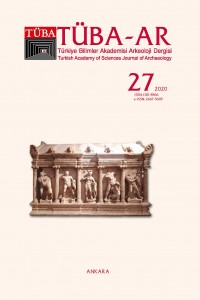THE ARZAWA LANDS. THE HISTORICAL GEOGRAPHY OF IZMIR AND ITS ENVIRONS DURING LATE BRONZE AGE IN THE LIGHT OF NEW ARCHAEOLOGICAL RESEARCH
Abstract
Keywords
References
- ABAY, E. 2011. “Preliminary Report on the Survey Project of Çivril Baklan and Çal Plains in the Upper Meander Basin Southwest Anatolia”, Ancient Near Eastern Studies Vol. 5: 1-87.
- BECKMAN, G. 1996. “Hittite Diplomatic Texts”, Society of Biblical Scholars. Atlanta.
- BECKMAN, et all. 2011. BECKMAN, G./BRYCE, T./CLINE, E. “The Ahhiyawa Texts, Writings from the Ancient World”, İn: (Ed.T. J. Lewis), Number 28. Atlanta.
- BRYCE, T. R. 2003. “History in: “The Luwians” in: (Ed. H. Craig Melchert), Handbook of Oriental Studies. Section 1 The Near and Middle East Vol. 68: 27-127.
- BRYCE, T. R. 2009. “The Peoples and Places of Ancient Western Asia”, Routledge, New York.
- CAHİLL, N. 2018. “Archaeological Exploration of Sardis”, Second Newsletter from Sardis 2017.
THE ARZAWA LANDS. THE HISTORICAL GEOGRAPHY OF IZMIR AND ITS ENVIRONS DURING LATE BRONZE AGE IN THE LIGHT OF NEW ARCHAEOLOGICAL RESEARCH
Abstract
The core of Arzawa (Arzawa Minor) before Mursili II is defined as the maritime Ephesos/Apasa region extending
from Mt. Arinnanda (Mykale), including also the inland settlement Puranda (Bademgediği Tepe).The boundaries of
Arzawa Minor were actually laid out generally by S. Heinhold - Krahmer and D. J. Hawkins. Nevertheles some minor
changes were undertaken in their schemes due to the discovery of new LBA sites and topographical observations in
the area.
Kaystros river basin and northern foothills of Mt. Tmolos from Karabel pass to the east seemed to constitute the land
of Mira which had a legitimate vassal kingdom after Mursili II and incorporated into Arzawa Minor. Considering the
northern foothills of Mt. Tmolos (Boz Dağı) belonging to Mira we have then an important clue to locate the cities of
Arsani, Sarawa, Impa and Hapanuwa which were fortified and garrisoned by Mursili II on his way from Seha River
land back to Mira, following a route from west to east. This was plausibly the same geographic order for the cities of
Mira in the texts. Now it seems conceivable to locate these towns along the foothills of Mt. Tmolos (Boz Dağı) after
the itinerary of Mursili II with the help of newly discovered LBA sites by the author or by other researchers.
New evidence for revising the boundaries of Kuwaliya provided the site for Elmacık near Uşak. The classical site
of Kaualia/Kabalia located at Elmacık is related to Kuwaliya. A prehistoric mound with LBA pottery discovered at
Elmacık is a hint that the area between Elmacık, Banaz and Akarçay (Astarpa) constituted the upper part of Kuwaliya
adjacent partly to the Siyanta River land in the North.
Consequently, this article contributes new information to the historical geography of İzmir and its surroundings in the
light of recent archaeological and topographical research.
Keywords
References
- ABAY, E. 2011. “Preliminary Report on the Survey Project of Çivril Baklan and Çal Plains in the Upper Meander Basin Southwest Anatolia”, Ancient Near Eastern Studies Vol. 5: 1-87.
- BECKMAN, G. 1996. “Hittite Diplomatic Texts”, Society of Biblical Scholars. Atlanta.
- BECKMAN, et all. 2011. BECKMAN, G./BRYCE, T./CLINE, E. “The Ahhiyawa Texts, Writings from the Ancient World”, İn: (Ed.T. J. Lewis), Number 28. Atlanta.
- BRYCE, T. R. 2003. “History in: “The Luwians” in: (Ed. H. Craig Melchert), Handbook of Oriental Studies. Section 1 The Near and Middle East Vol. 68: 27-127.
- BRYCE, T. R. 2009. “The Peoples and Places of Ancient Western Asia”, Routledge, New York.
- CAHİLL, N. 2018. “Archaeological Exploration of Sardis”, Second Newsletter from Sardis 2017.
Details
| Primary Language | English |
|---|---|
| Subjects | Archaeology |
| Journal Section | Research Articles |
| Authors | |
| Publication Date | December 31, 2020 |
| Submission Date | March 16, 2020 |
| Published in Issue | Year 2020 Issue: 27 |
Cite
Cited By
Publisher
Vedat Dalokay Caddesi No: 112 Çankaya 06670 ANKARA
TÜBA-AR Turkish Academy of Sciences Journal of Archaeology (TÜBA-AR) does not officially endorse the views expressed in the articles published in the journal, nor does it guarantee any product or service advertisements that may appear in the print or online versions. The scientific and legal responsibility for the published articles belongs solely to the authors.
Images, figures, tables, and other materials submitted with manuscripts must be original. If previously published, written permission from the copyright holder must be provided for reproduction in both print and online versions. Authors retain the copyright of their works; however, upon publication in the journal, the economic rights and rights of public communication -including adaptation, reproduction, representation, printing, publishing, and distribution rights- are transferred to the Turkish Academy of Sciences (TÜBA), the publisher of the journal. Copyright of all published content (text and visual materials) belongs to the journal in terms of usage and distribution. No payment is made to the authors under the name of copyright or any other title, and no article processing charges are requested. However, the cost of reprints, if requested, is the responsibility of the authors.
In order to promote global open access to scientific knowledge and research, TÜBA allows all content published online (unless otherwise stated) to be freely used by readers, researchers, and institutions. Such use (including linking, downloading, distribution, printing, copying, or reproduction in any medium) is permitted under the Creative Commons Attribution-NonCommercial-NoDerivatives 4.0 International (CC BY-NC-ND 4.0) License, provided that the original work is properly cited, not modified, and not used for commercial purposes. For permission regarding commercial use, please contact the publisher.

